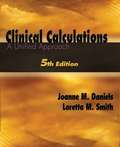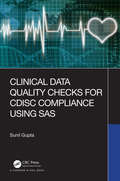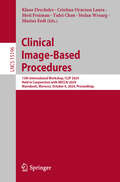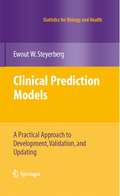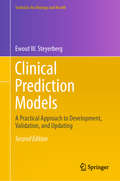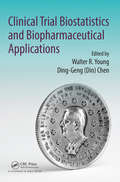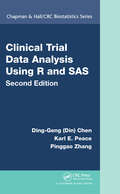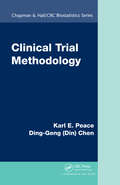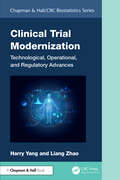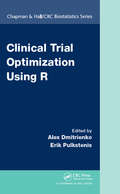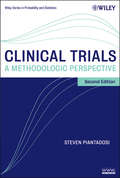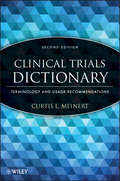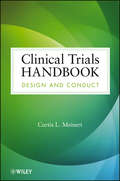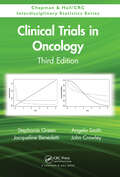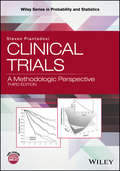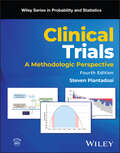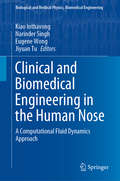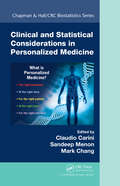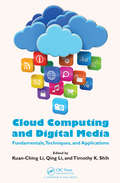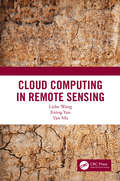- Table View
- List View
Clinical Calculations: A Unified Approach (5th edition)
by Loretta M. Smith Joanne M. DanielsThe original is now a classic. Clinical Calculations was the first text to introduce the dimensional analysis method of calculating dosages, an approach rapidly becoming the method of choice for nurses. The fifth edition of this trailblazer showcases its proven strengths: a clear writing style, workbook-style format, strong IV therapy content, and clinical applicability. Critical thinking is encouraged in conjunction with memorized rules by asking learners to always consider whether their answers make sense. It does this within the context of providing the core knowledge-base for dosage calculation and administration for learners of all levels and experience. Chapters cover the range of practice, including systems of measurement, oral and parenteral medications, basic and advanced intravenous medications, and pediatric dosage. Just as the title suggests, this resource is the ideal tool for calculation in a clinical setting. With copious reference tools, outlined injection sites for IV therapy, and unique performance criteria for evaluating nurse competency, the tradition of excellence and innovation continues.
Clinical Coding Workout 2017: Practice Exercises for Skill Development with Odd-Numbered Online Answers
by American Medical AssociationClinical Coding Workout: Practice Exercises for Skill Development, with Odd-numbered Online Answers
Clinical Data Quality Checks for CDISC Compliance Using SAS
by Sunil GuptaClinical Data Quality Checks for CDISC Compliance using SAS is the first book focused on identifying and correcting data quality and CDISC compliance issues with real-world innovative SAS programming techniques such as Proc SQL, metadata and macro programming. Learn to master Proc SQL’s subqueries and summary functions for multi-tasking process. Drawing on his more than 25 years’ experience in the pharmaceutical industry, the author provides a unique approach that empowers SAS programmers to take control of data quality and CDISC compliance. This book helps you create a system of SDTM and ADaM checks that can be tracked for continuous improvement. How often have you encountered issues such as missing required variables, duplicate records, invalid derived variables and invalid sequence of two dates? With the SAS programming techniques introduced in this book, you can start to monitor these and more complex data and CDISC compliance issues. With increased standardization in SDTM and ADaM specifications and data values, codelist dictionaries can be created for better organization, planning and maintenance. This book includes a SAS program to create excel files containing unique values from all SDTM and ADaM variables as columns. In addition, another SAS program compares SDTM and ADaM codelist dictionaries with codelists from define.xml specifications. Having tools to automate this process greatly saves time from doing it manually. Features SDTMs and ADaMs Vitals SDTMs and ADaMs Data CDISC Specifications Compliance CDISC Data Compliance Protocol Compliance Codelist Dictionary Compliance
Clinical Image-Based Procedures: 13th International Workshop, CLIP 2024, Held in Conjunction with MICCAI 2024, Marrakesh, Morocco, October 6, 2024, Proceedings (Lecture Notes in Computer Science #15196)
by Cristina Oyarzun Laura Stefan Wesarg Klaus Drechsler Marius Erdt Yufei Chen Moti FreimanThis book constitutes the proceedings of the 13th Workshop on Clinical Image-Based Procedures, CLIP 2024, held in conjunction with the 27th International conference on Medical Image Computing and Computer Assisted Intervention, MICCAI 2024, in Marrakesh, Morocco in October 2024. The 9 full papers included in this book were carefully reviewed and selected from 11 submissions. They deal with Clinical image-based procedures, focusing on holistic patient models as an important step towards personalized healthcare.
Clinical Laboratory Mathematics
by Mark BallThis accessible text brings together mathematical techniques that will be indispensable to every student, teacher, practitioner, and user of chemistry- or biology-related laboratory work. Responding to the concerns of both instructors and students, CLINICAL LABORATORY MATHEMATICS begins with a review of arithmetic and algebra. Next, it presents example-rich chapters on exponential notation and logarithms, rounding and figure significance, measurement systems, solutions and concentrations, dilutions, proportionality, graphs, rates of change, statistics, chemistry, quality control, and method evaluation. It answers frequently asked questions, identifies common misunderstandings, and offers an optional advanced section online. Throughout, the author explains why a solid understanding of math is critical in today's high-technology clinical laboratories. Practice problems are strategically designed to present real-world scenarios with both context and consequence. Supporting both self-guided study and traditional lecture-discussion, the text is logically organized and liberally cross-referenced, revealing hidden connections and common motifs.
Clinical Prediction Models: A Practical Approach to Development, Validation, and Updating (Statistics for Biology and Health)
by Ewout W. SteyerbergThis book aims to provide insight and practical illustrations on how modern statistical concepts and regression methods can be applied in medical prediction problems, including diagnostic and prognostic outcomes. Many advances have been made in statistical approaches towards outcome prediction, but these innovations are insufficiently applied in medical research. Old-fashioned, data hungry methods are often used in data sets of limited size, validation of predictions is not done or only in a simplistic way, and updating of already available models is not considered. A sensible strategy is needed for model development, validation, and updating, such that prediction models can better support medical practice. Clinical Prediction Models presents a practical checklist with seven steps that need to be considered for development of a valid prediction model. These include preliminary considerations such as dealing with missing values; coding of predictors; selection of main effects and interactions for a multivariable model; estimation of model parameters with shrinkage methods and incorporation of external data; evaluation of performance and clinical usefulness; internal validation; and presentation format. The steps are illustrated with many small case studies and R computer code, with data sets made available in the public domain [http://www.clinicalpredictionmodels.org/]. The book further focuses on generalizability of prediction models, including patterns of invalidity that may be encountered in new settings, approaches to modifying and extending a model, and comparisons of centers after case-mix adjustment by a prediction model. The text is primarily intended for epidemiologists and applied biostatisticians. It can be used as a textbook for a graduate course on predictive modeling in diagnosis and prognosis. It is beneficial if readers are familiar with common statistical models in medicine: linear regression, logistic regression, and Cox regression. The book is practical in nature. But it also provides a philosophical perspective on data analysis in medicine that goes beyond predictive modeling. In this era of evidence-based medicine, randomized clinical trials are the basis for assessment of treatment efficacy. Prediction models are key to individualizing diagnostic and treatment decision-making.
Clinical Prediction Models: A Practical Approach to Development, Validation, and Updating (Statistics for Biology and Health)
by Ewout W. SteyerbergThe second edition of this volume provides insight and practical illustrations on how modern statistical concepts and regression methods can be applied in medical prediction problems, including diagnostic and prognostic outcomes. Many advances have been made in statistical approaches towards outcome prediction, but a sensible strategy is needed for model development, validation, and updating, such that prediction models can better support medical practice.There is an increasing need for personalized evidence-based medicine that uses an individualized approach to medical decision-making. In this Big Data era, there is expanded access to large volumes of routinely collected data and an increased number of applications for prediction models, such as targeted early detection of disease and individualized approaches to diagnostic testing and treatment. Clinical Prediction Models presents a practical checklist that needs to be considered for development of a valid prediction model. Steps include preliminary considerations such as dealing with missing values; coding of predictors; selection of main effects and interactions for a multivariable model; estimation of model parameters with shrinkage methods and incorporation of external data; evaluation of performance and usefulness; internal validation; and presentation formatting. The text also addresses common issues that make prediction models suboptimal, such as small sample sizes, exaggerated claims, and poor generalizability. The text is primarily intended for clinical epidemiologists and biostatisticians. Including many case studies and publicly available R code and data sets, the book is also appropriate as a textbook for a graduate course on predictive modeling in diagnosis and prognosis. While practical in nature, the book also provides a philosophical perspective on data analysis in medicine that goes beyond predictive modeling. Updates to this new and expanded edition include:• A discussion of Big Data and its implications for the design of prediction models• Machine learning issues• More simulations with missing ‘y’ values• Extended discussion on between-cohort heterogeneity• Description of ShinyApp• Updated LASSO illustration• New case studies
Clinical Research Transformed
by Olli S. Miettinen Johann Steurer Albert HofmanIn this Information Age, the practices of clinical medicine should no longer be based on what clinical doctors actively know. Rather, all of the importantly practice-relevant knowledge should not only already exist but also be codified in cyberspace, in directly practice-guiding 'expert systems' -- for the benefit of both doctors and patients everywhere. Each of these systems (discipline-specific) would, prompted by a particular type of case presentation, present the doctor a questionnaire specific to cases of the type at issue, and document the doctor's answers to the questions. If at issue would be a case of complaint about a (particular type of) sickness, the system would translate the resulting diagnostic profile of the case into the corresponding probabilities of the illnesses to be considered. Similarly, if at issue would be an already-diagnosed case of a particular illness, the system would ask about, and record, the relevant elements in the prognostic profile of the case and then translate this profile into the probabilities of various outcomes to be considered, probabilities specific to the choice of treatment and prospective time in addition to that profile. And besides, these systems would analogously address the causal origin -- etiogenesis -- of cases of particular types of illness. While the requisite knowledge-base for these systems -- notably for the probabilities in them -- has not been addressed by such 'patient-oriented' clinical research as has been conducted (very extensively) up to now, this book delineates the nature of the suitably-transformed research (gnostic). The critically-transformative innovation in the research is the studies' focus on Gnostic Probability Functions -- dia-, etio-, and prognostic -- in the framework of logistic regression models. This book also presents a vision of how this critically-transformative research would most expeditiously be provided for and also conducted, among select sets of academic teaching hospitals.
Clinical Trial Biostatistics and Biopharmaceutical Applications
by Ding-Geng Din Chen Walter R. YoungSince 1945, "The Annual Deming Conference on Applied Statistics" has been an important event in the statistics profession. In Clinical Trial Biostatistics and Biopharmaceutical Applications, prominent speakers from past Deming conferences present novel biostatistical methodologies in clinical trials as well as up-to-date biostatistical applications
Clinical Trial Data Analysis Using R and SAS (Chapman & Hall/CRC Biostatistics Series)
by Ding-Geng Chen Pinggao Zhang Karl PeaceReview of the First Edition "The goal of this book, as stated by the authors, is to fill the knowledge gap that exists between developed statistical methods and the applications of these methods. Overall, this book achieves the goal successfully and does a nice job. I would highly recommend it …The example-based approach is easy to follow and makes the book a very helpful desktop reference for many biostatistics methods."—Journal of Statistical Software Clinical Trial Data Analysis Using R and SAS, Second Edition provides a thorough presentation of biostatistical analyses of clinical trial data with step-by-step implementations using R and SAS. The book’s practical, detailed approach draws on the authors’ 30 years’ experience in biostatistical research and clinical development. The authors develop step-by-step analysis code using appropriate R packages and functions and SAS PROCS, which enables readers to gain an understanding of the analysis methods and R and SAS implementation so that they can use these two popular software packages to analyze their own clinical trial data. What’s New in the Second Edition Adds SAS programs along with the R programs for clinical trial data analysis. Updates all the statistical analysis with updated R packages. Includes correlated data analysis with multivariate analysis of variance. Applies R and SAS to clinical trial data from hypertension, duodenal ulcer, beta blockers, familial andenomatous polyposis, and breast cancer trials. Covers the biostatistical aspects of various clinical trials, including treatment comparisons, time-to-event endpoints, longitudinal clinical trials, and bioequivalence trials.
Clinical Trial Methodology (Chapman & Hall/CRC Biostatistics Series)
by Karl E. Peace Ding-Geng (Din) ChenNow viewed as its own scientific discipline, clinical trial methodology encompasses the methods required for the protection of participants in a clinical trial and the methods necessary to provide a valid inference about the objective of the trial. Drawing from the authors' courses on the subject as well as the first author's more than 30 years wor
Clinical Trial Modernization: Technological, Operational, and Regulatory Advances (Chapman & Hall/CRC Biostatistics Series)
by Liang Zhao Harry YangAs the pharmaceutical industry navigates this new era of technological innovation, the integration of AI, big data, and advanced analytics into clinical trials holds immense potential to transform drug development. Clinical Trial Modernization: Technological, Operational, and Regulatory Advances provides a comprehensive overview of the current trends, challenges, and opportunities in modernizing clinical trials, offering a roadmap for stakeholders in this evolving field.This book serves as a valuable resource for professionals, researchers, and regulators, providing actionable insights into the future of clinical trials and their critical role in bringing new therapies to market faster and more effectively.
Clinical Trial Optimization Using R (Chapman & Hall/CRC Biostatistics Series)
by Alex Dmitrienko; Erik PulkstenisClinical Trial Optimization Using R explores a unified and broadly applicable framework for optimizing decision making and strategy selection in clinical development, through a series of examples and case studies. It provides the clinical researcher with a powerful evaluation paradigm, as well as supportive R tools, to evaluate and select among simultaneous competing designs or analysis options. It is applicable broadly to statisticians and other quantitative clinical trialists, who have an interest in optimizing clinical trials, clinical trial programs, or associated analytics and decision making. This book presents in depth the Clinical Scenario Evaluation (CSE) framework, and discusses optimization strategies, including the quantitative assessment of tradeoffs. A variety of common development challenges are evaluated as case studies, and used to show how this framework both simplifies and optimizes strategy selection. Specific settings include optimizing adaptive designs, multiplicity and subgroup analysis strategies, and overall development decision-making criteria around Go/No-Go. After this book, the reader will be equipped to extend the CSE framework to their particular development challenges as well.
Clinical Trials
by Steven PiantadosiLearn rigorous statistical methods to ensure valid clinical trialsThis Second Edition of the critically hailed Clinical Trials builds on the text's reputation as a straightforward and authoritative presentation of statistical methods for clinical trials. Readers are introduced to the fundamentals of design for various types of clinical trials and then skillfully guided through the complete process of planning the experiment, assembling a study cohort, assessing data, and reporting results. Throughout the process, the author alerts readers to problems that may arise during the course of the trial and provides commonsense solutions.The author bases the revisions and updates on his own classroom experience, as well as feedback from students, instructors, and medical and statistical professionals involved in clinical trials. The Second Edition greatly expands its coverage, ranging from statistical principles to controversial topics, including alternative medicine and ethics. At the same time, it offers more pragmatic advice for issues such as selecting outcomes, sample size, analysis, reporting, and handling allegations of misconduct. Readers familiar with the First Edition will discover completely new chapters, including:* Contexts for clinical trials* Statistical perspectives* Translational clinical trials* Dose-finding and dose-ranging designsEach chapter is accompanied by a summary to reinforce the key points. Revised discussion questions stimulate critical thinking and help readers understand how they can apply their newfound knowledge, and updated references are provided to direct readers to the most recent literature.This text distinguishes itself with its accessible and broad coverage of statistical design methods--the crucial building blocks of clinical trials and medical research. Readers learn to conduct clinical trials that produce valid qualitative results backed by rigorous statistical methods.
Clinical Trials Dictionary
by Curtis L. MeinertA thoroughly updated new edition of the essential reference on the design, practice, and analysis of clinical trials Clinical Trials Dictionary: Terminology and Usage Recommendations, Second Edition presents clear, precise, meticulously detailed entries on all aspects of modern-day clinical trials. Written and compiled by one of the world's leading clinical trialists, this comprehensive volume incorporates areas of medicine, statistics, epidemiology, computer science, and bioethics--providing a treasure trove of key terms and ideas. This new edition continues to supply readers with the A-Z terminology needed to design, conduct, and analyze trials, introducing a vocabulary for the characterization and description of related features and activities. More than 300 new entries are now included, reflecting the current usage practices and conventions in the field, along with usage notes with recommendations on when to use the term in question. Detailed biographical notes highlight prominent historical figures and institutions in the field, and an extensive bibliography has been updated to provide readers with additional resources for further study. The most up-to-date work of its kind, Clinical Trials Dictionary, Second Edition is an essential reference for anyone who needs to report on, index, analyze, or assess the scientific strength and validity of clinical trials.
Clinical Trials Handbook
by Curtis L. MeinertA systematic approach to all aspects of designing and conducting clinical trialsThe success or failure of clinical trials hinges on hundreds of details that need to be developed, often under less than ideal conditions. Written by one of the world's leading trialists, Clinical Trials Handbook: Design and Conduct provides clinicians with a complete guide to designing, conducting, and evaluating clinical trials--teaching them how to simplify the process and avoid costly mistakes.The author draws on his extensive clinical trials experience to outline all steps employed in setting up and running clinical trials, from budgeting and fundraising to publishing the results. Along the way, practical advice is offered while also addressing a mix of logistical, ethical, psychological, behavioral, and administrative issues inherent to clinical trials. Topics of coverage include:Protocols for drug masking, controls, and treatment randomizationConsent, enrollment, eligibility, and follow-up proceduresDifferent types of sample size design and data collection and processingWorking with study centers, research staff, and various committeesMonitoring treatment effects and performance, and ensuring quality controlData analysis and access policies for study data and documentsClinical Trials Handbook is invaluable for practicing clinicians and trialists who would like to learn more about or improve their understanding of the design and execution of clinical trials. The book is also an excellent supplement for courses on clinical trials at the graduate level.
Clinical Trials in Oncology (Chapman & Hall/CRC Interdisciplinary Statistics #28)
by Stephanie Green Jacqueline BenedettiThe new edition of the bestselling Clinical Trials in Oncology provides a concise, nontechnical, and now thoroughly up-to-date review of methods and issues related to clinical trials. The authors emphasize the importance of proper study design, analysis, and data management and identify the pitfalls inherent in these processes. This edition includes a new section covering innovations in Phase I designs and another on overcoming the challenges of array data. As always, the authors use clear, lucid prose and a multitude of real-world trials as examples to convey the principles of successful trials without the need for a strong statistics or mathematics background.
Clinical Trials: A Methodologic Perspective
by Steven PiantadosiPresents elements of clinical trial methods that are essential in planning, designing, conducting, analyzing, and interpreting clinical trials with the goal of improving the evidence derived from these important studies This Third Edition builds on the text's reputation as a straightforward, detailed, and authoritative presentation of quantitative methods for clinical trials. Readers will encounter the principles of design for various types of clinical trials, and are then skillfully guided through the complete process of planning the experiment, assembling a study cohort, assessing data, and reporting results. Throughout the process, the author alerts readers to problems that may arise during the course of the trial and provides common sense solutions. All stages of therapeutic development are discussed in detail, and the methods are not restricted to a single clinical application area. The authors bases current revisions and updates on his own experience, classroom instruction, and feedback from teachers and medical and statistical professionals involved in clinical trials. The Third Edition greatly expands its coverage, ranging from statistical principles to new and provocative topics, including alternative medicine and ethics, middle development, comparative studies, and adaptive designs. At the same time, it offers more pragmatic advice for issues such as selecting outcomes, sample size, analysis, reporting, and handling allegations of misconduct. Readers familiar with the First and Second Editions will discover revamped exercise sets; an updated and extensive reference section; new material on endpoints and the developmental pipeline, among others; and revisions of numerous sections. In addition, this book: * Features accessible and broad coverage of statistical design methods--the crucial building blocks of clinical trials and medical research -- now complete with new chapters on overall development, middle development, comparative studies, and adaptive designs * Teaches readers to design clinical trials that produce valid qualitative results backed by rigorous statistical methods * Contains an introduction and summary in each chapter to reinforce key points * Includes discussion questions to stimulate critical thinking and help readers understand how they can apply their newfound knowledge * Provides extensive references to direct readers to the most recent literature, and there are numerous new or revised exercises throughout the book Clinical Trials: A Methodologic Perspective, Third Edition is a textbook accessible to advanced undergraduate students in the quantitative sciences, graduate students in public health and the life sciences, physicians training in clinical research methods, and biostatisticians and epidemiologists. Steven Piantadosi, MD, PhD, is the Phase One Foundation Distinguished Chair and Director of the Samuel Oschin Cancer Institute, and Professor of Medicine at Cedars-Sinai Medical Center in Los Angeles, California. Dr. Piantadosi is one of the world's leading experts in the design and analysis of clinical trials for cancer research. He has taught clinical trials methods extensively in formal courses and short venues. He has advised numerous academic programs and collaborations nationally regarding clinical trial design and conduct, and has served on external advisory boards for the National Institutes of Health and other prominent cancer programs and centers. The author of more than 260 peer-reviewed scientific articles, Dr. Piantadosi has published extensively on research results, clinical applications, and trial methodology. While his papers have contributed to many areas of oncology, he has also collaborated on diverse studies outside oncology including lung disease and degenerative neurological disease.
Clinical Trials: A Methodologic Perspective (WILEY SERIES IN PROB & STATISTICS/see 1345/6,6214/5 #593)
by Steven PiantadosiClinical Trials Comprehensive resource presenting methods essential in planning, designing, conducting, analyzing, and interpreting clinical trials The Fourth Edition of Clinical Trials builds on the text’s reputation as a straightforward, detailed, and authoritative presentation of quantitative methods for clinical trials, discussing principles of design for various types of clinical trials and elements of planning the experiment, assembling a study cohort, assessing data, and reporting results. Each chapter contains an introduction and summary to reinforce key points. Discussion questions stimulate critical thinking and help readers understand how they can apply their newfound knowledge. Written by a highly qualified author with significant experience in the field, the Fourth Edition of Clinical Trials approaches the topic with: Problems that may arise during a trial, and accompanying common sense solutionsDesign alternatives for addressing many questions in therapeutic developmentStatistical principles with new and provocative topics, such as generalizing results, operating characteristics, trial issues during the COVID-19 pandemic, and moreAlternative medicine, ethics, middle development, comparative studies, adaptive designs, and clinical trials using point of care dataRevamped exercise sets, updated and extensive references, new material on endpoints and the developmental pipeline, and revisions of numerous sections, tables, and figures Standing out due to its accessible and broad coverage of statistical design methods which are the building blocks of clinical trials and medical research, Clinical Trials is an essential learning aid on the subject for undergraduate and graduate clinical trials courses.
Clinical and Biomedical Engineering in the Human Nose: A Computational Fluid Dynamics Approach (Biological and Medical Physics, Biomedical Engineering)
by Jiyuan Tu Kiao Inthavong Narinder Singh Eugene WongThis book explores computational fluid dynamics in the context of the human nose, allowing readers to gain a better understanding of its anatomy and physiology and integrates recent advances in clinical rhinology, otolaryngology and respiratory physiology research. It focuses on advanced research topics, such as virtual surgery, AI-assisted clinical applications and therapy, as well as the latest computational modeling techniques, controversies, challenges and future directions in simulation using CFD software. Presenting perspectives and insights from computational experts and clinical specialists (ENT) combined with technical details of the computational modeling techniques from engineers, this unique reference book will give direction to and inspire future research in this emerging field.
Clinical and Statistical Considerations in Personalized Medicine
by Mark Chang Claudio Carini Sandeep MenonClinical and Statistical Considerations in Personalized Medicine explores recent advances related to biomarkers and their translation into clinical development. Leading clinicians, biostatisticians, regulators, commercial professionals, and researchers address the opportunities and challenges in successfully applying biomarkers in drug discovery and preclinical and clinical development.Robust Biomarkers for Drug Development and Disease TreatmentThe first four chapters discuss biomarker development from a clinical perspective. Coverage ranges from an introduction to biomarkers to advances in RNAi screens, epigenetics, and rare diseases as targets for personalized medicine approaches. Subsequent chapters examine the statistical considerations in applying a personalized medicine approach, including multiplicity in pharmacogenomics. The last chapter assesses the regulatory issues involved in using biomarkers.Improve Patient Care and Reduce Costs and Side EffectsDespite the vast amount of literature on biomarkers, there is no comprehensive book that integrates the clinical and statistical components. This book is one of the first to incorporate both the clinical and statistical aspects of biomarkers in the personalized medicine paradigm. Covering a wide spectrum of personalized medicine-related topics, it presents state-of-the-art techniques for advancing the application of biomarkers in drug discovery and development.
Close Encounters of Art and Physics: An Artist's View
by Laura PesceClose Encounters of Art and Physics is a voyage in time through the abstract ideas harboured in the minds of humans, starting from the graffiti art of cave dwellers and extending to the street art of contemporary men and women. In seeking parallels with science, the author looks far back to the first geometric ideas of our ancestors as well as ahead to the contemporary science of present-day physicists. The parallelism and analogies between these two fields bear witness to a real entanglement in the human brain. The second part of the book contains about 25 colour images showing the author's stunning glass artwork representing ideas such as dark matter, quantum entanglement, cellular automata and many others that are almost impossible to capture in words. Furthermore, many of the physicists who have themselves made major contributions in these fields provide their comments and analysis of the works. The book provides entertaining and informative reading, not only for practicing artists and physicists, but also anyone curious about art and physics.
Closure Properties for Heavy-Tailed and Related Distributions: An Overview (SpringerBriefs in Statistics)
by Remigijus Leipus Jonas Šiaulys Dimitrios KonstantinidesThis book provides a compact and systematic overview of closure properties of heavy-tailed and related distributions, including closure under tail equivalence, convolution, finite mixing, maximum, minimum, convolution power and convolution roots, and product-convolution closure. It includes examples and counterexamples that give an insight into the theory and provides numerous references to technical details and proofs for a deeper study of the subject. The book will serve as a useful reference for graduate students, young researchers, and applied scientists.
Cloud Computing and Digital Media: Fundamentals, Techniques, and Applications
by Qing Li Timothy K. Shih Kuan-Ching LiCloud Computing and Digital Media: Fundamentals, Techniques, and Applications presents the fundamentals of cloud and media infrastructure, novel technologies that integrate digital media with cloud computing, and real-world applications that exemplify the potential of cloud computing for next-generation digital media. It brings together technologie
Cloud Computing in Remote Sensing
by Lizhe Wang Yan Ma Jining YanThis book provides the users with quick and easy data acquisition, processing, storage and product generation services. It describes the entire life cycle of remote sensing data and builds an entire high performance remote sensing data processing system framework. It also develops a series of remote sensing data management and processing standards. Features: Covers remote sensing cloud computing Covers remote sensing data integration across distributed data centers Covers cloud storage based remote sensing data share service Covers high performance remote sensing data processing Covers distributed remote sensing products analysis
